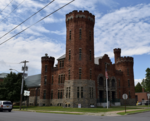Judge John Fine House
1823 establishments in New York (state)Greek Revival houses in New York (state)Houses completed in 1823Houses in St. Lawrence County, New YorkHouses on the National Register of Historic Places in New York (state) ... and 2 more
National Register of Historic Places in St. Lawrence County, New YorkSt. Lawrence County, New York Registered Historic Place stubs
Judge John Fine House is a historic home located at Ogdensburg in St. Lawrence County, New York. It is a 2-story, three-bay Greek Revival-style residence appended to an earlier 1+1⁄2-story rear wing, built about 1823. Both sections are built of local blue limestone and feature gabled roofs.It was listed on the National Register of Historic Places in 1986.
Excerpt from the Wikipedia article Judge John Fine House (License: CC BY-SA 3.0, Authors).Judge John Fine House
State Street, City of Ogdensburg
Geographical coordinates (GPS) Address Nearby Places Show on map
Geographical coordinates (GPS)
| Latitude | Longitude |
|---|---|
| N 44.696111111111 ° | E -75.491388888889 ° |
Address
State Street 416
13669 City of Ogdensburg
New York, United States
Open on Google Maps







